« Prev Next »

Individual organisms in a community interact in many different ways. An interaction may benefit both individuals, or the interaction may benefit one organism to the detriment of the other. An interaction between two organisms that benefits one to the detriment of the other is an antagonistic interaction. Predation, herbivory, and parasitism are specific types of antagonistic interactions.
Predation
The best-known examples of predation involve carnivorous interactions, in which one animal consumes another. Think of wolves hunting moose, owls hunting mice, or shrews hunting worms and insects. Less obvious carnivorous interactions involve many small individuals consuming a larger one. Such group predation is common among social carnivores such as lions, hyenas, and wolves. Group predation also occurs with ants and social spiders. This is, however, only part of the picture. Seed consumption can sometimes constitute predation. Seeds are considered organisms. Under ideal circumstances, seeds grow to become plants. However, consumption of a seed kills the plant before it can grow, making seed consumption an example of predation.
Not all predators are animals. Carnivorous plants, such as the Venus fly trap and the pitcher plant, consume insects. Pitcher plants catch their prey in a pool of water containing digestive enzymes, whereas the Venus fly trap captures an insect between the two lobes of a leaf and seals the insect inside with digestive enzymes. These plants absorb nutrients from the insects as they become available during digestion. On a microscopic scale, protozoa and bacteria also consume prey organisms. They play an important role in maintaining population sizes in microbial communities, which promotes the diversity of microorganisms and contributes to a stable community structure.
Predation and Adaptation
Predation influences the fitness of both predators and prey. Individuals must both feed and avoid being eaten to survive and reproduce. Genetically-determined traits that improve an organism’s ability to survive and reproduce will be passed on to its offspring. Traits associated with improved predation for predators and escaping predation for prey tend to be positively selected by natural selection.
Predators exhibit traits such as sharp teeth, claws, and venom that enhance their ability to catch food. They also possess extremely acute sensory organs that help them to find potential prey. Consider the ability of raptors to spot potential prey from over a kilometer away, the acute sense of smell of moles, the ability of owls to locate mice by sound, the ability of pit vipers to sense body heat when tracking prey, and the ability of bats and dolphins to echolocate. Predators catch their prey either by pursuing potential prey or by ambushing them. Organisms that give chase are capable of short bursts of speed. Those that lie in wait tend to be camouflaged to avoid detection (Figure 1).
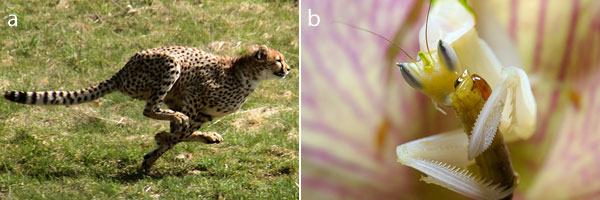
In a similar manner, prey species exhibit traits that help them avoid detection or capture. Many, such as leaf insects, moths, a variety of frogs and small lizards, and herbivorous mammals, are cryptically colored to make them more difficult to see. Behaviorally, they freeze after detecting the presence of a predator. This lack of movement helps them better blend in with their background and inhibits the ability of the predator to find them. But when predators venture too close, prey will take flight, running or flying to escape. When a chase ensues, prey will typically survive if they stay out of reach until the predator tires. Some species buy extra time by distracting the predator. Examples include moths that flash brightly colored hindwings, lizards that drop their tails, and insect larvae that discharge slime. Such actions surprise the predator and give the prey time a few extra moments to escape.
When a predator chases after potential prey, the predator is running for its dinner. The prey is running for its life. If the predator fails to capture the prey, it goes hungry, but it will not experience a large decline in fitness as a result of the interaction. In contrast, if the predator catches the prey, the captured individual loses any future opportunities to reproduce. This “life-dinner principle” sets up an evolutionary arms race between the two species (Dawkins & Krebs 1979). In this race, the prey experience strong selective pressure to evolve better adaptations to avoid being eaten. At the same time, predators must capture sufficient food to survive and reproduce, and they too are subjected to selective pressure for traits that allow them to hunt successfully. Over time, this arms race leads to traits that enable prey to better avoid capture, whereas predators become better able to capture prey.
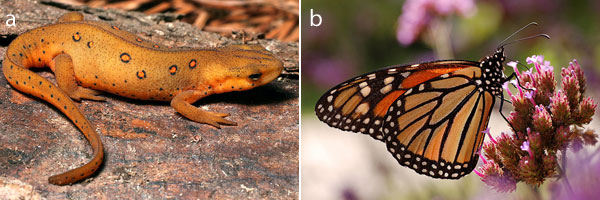
In contrast to the examples provided thus far, some prey exhibit bright coloration. Such aposematic coloration helps prevent predation by signaling to potential predators that the vividly-colored individual is toxic. Toxins may be manufactured within the body, as with the red-spotted newt, or they may be acquired passively via consumption of toxic plants, as with the monarch butterfly (Figure 2).
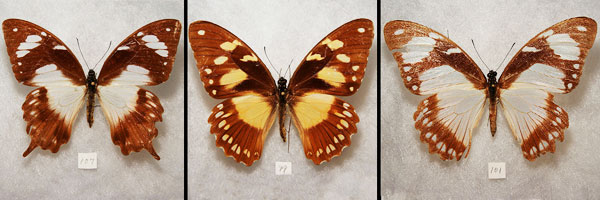
Not all species that exhibit vivid coloration are truly toxic. Some have evolved patterns and colors that mimic those of toxic species. Examples of such Batesian mimicry include the extraordinarily polymorphic Papilio dardanus swallowtail butterfly in southern Africa and Madagascar (Salvato 1997). Females of this species occur in a wide variety of physical appearances, nearly all of which mimic distasteful species of the Danaeus and Amauris genera with which they co-occur (Figure 3).
Herbivory
To maximize nutrient intake, many herbivores have evolved adaptations that allow them to determine which plants contain fewer defensive compounds and more high-quality nutrients. Some insects, such as butterflies, have chemical sensors on their feet that allow them to taste the plant before they consume any part of it. Mammalian herbivores often use their keen sense of smell to detect bitter compounds, and they preferentially eat younger leaves that contain fewer chemicals.
Parasitism
In parasitism, an individual organism, the parasite, consumes nutrients from another organism, its host, resulting in a decrease in fitness to the host. In extreme cases, parasites can cause disease in the host organism; in these situations, we refer to them as pathogens. We divide parasites into two categories: endoparasites, which live inside the body of their hosts, and ectoparasites, which live and feed on the outside of the body of their host. Examples of endoparasites include flukes, tapeworms, fungi, bacteria, and protozoa. Ectoparasites include ticks and lice, plants, protozoa, bacteria, and fungi. Plants and animals typically act as hosts.
In most situations, parasites do not kill their hosts. An exception, however, occurs with parasitoids, which blur the line between parasitism and predation. The best-known parasitoids include several species of wasp, which immobilize — but do not kill — a host by stinging it. The female then carries the host to a burrow, where she lays eggs within the host’s body. After the larvae hatch, they consume the living tissues of the host, eventually killing it (Figure 4a).
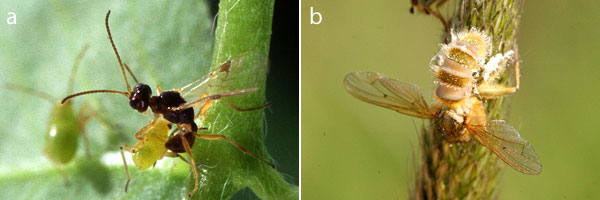
Entomogenous fungi also act as parasitoids; they infect the bodies of insects, either through the mouth while foraging or by penetrating the outer cuticle of the insect’s body (Ferron 1978, Roy et al. 2006). Spores circulate inside the host, whose body provides the nutrients needed for fungal growth. Eventually, the fungal load becomes too great for the host, and the insect dies (Figure 4b). The major distinguishing difference between parasitoids and predators is that parasitoids feed on living tissue, whereas the predator kills its prey before, or in the process of, consuming it.
Parasite Transmission
For all parasites, the host exists as an island of habitat. But the island lives for a finite period of time, and the parasites must find a new host before the existing one dies. Transmission to a new host can happen either directly, or through a vector. In direct transmission, the parasite moves from one host to another of the same species without an intermediate organism. In vector transmission, an intermediate organism, the vector, transfers the parasite from one host to the next.
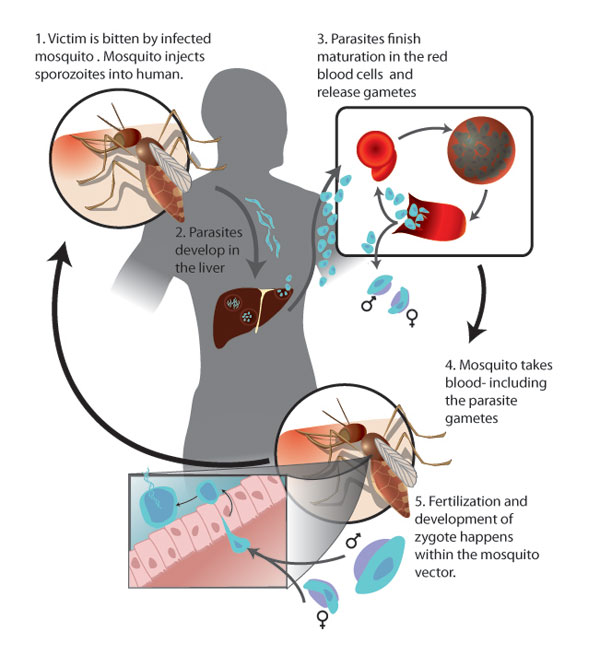
Many endoparasites have a complex life cycle that involves two hosts, and the parasite must spend time in both to complete its life cycle. Take, for example, the protozoan parasite Plasmodium, which causes malaria. Plasmodium must spend time in humans and in an Anopheles mosquito to complete its life cycle. The mosquito acts as a vector, transferring Plasmodium from infected humans to uninfected individuals. Additionally, the mosquito acts as an intermediate host. When a female mosquito ingests blood containing Plasmodium, some of the red blood cells contain gametes (eggs and sperm). In the mosquito’s gut, the gametes come together to form a zygote, the development of which results in sporozoites. It is this life stage that can then go on to infect a new human when the mosquito feeds (Figure 5).
Summary
Herbivorous, predatory, and parasitic interactions among organisms within communities regulate population sizes by preventing any one population from becoming overly abundant. Each type of interaction becomes more likely as the population size of the food source increases. Thus these interactions are essential to maintaining the diversity of organisms that make up an ecological community. Each of these interactions can alter the balance of the food web, and removal of any part of the web can have a drastic impact on the community.
References and Recommended Reading
Coley, P. D. & Barone J. A. Herbivory and plant defenses in tropical forests. Annual Review of Ecology and Systematics 27, 305-335 (1996).
Dawkins, R. & Krebs, J. Arms races between and within species. Proceedings of the Royal Society, London, Series B, Biological Sciences 205, 489-511 (1979).
Ferron, P. Biological control of insect pests by entomogenous fungi. Annual Reviews of Entomology 23, 409-442 (1978).
Roy, H. E., Steinkraus, D. C., et al. Bizarre interactions and endgames: entomopathic fungi and their arthropod hosts. Annual Review of Entomology 51, 331-357 (2006).
Salvato, M. Most Spectacular Batesian Mimicry. In University of Florida Book of Insect Records, 1997.






























